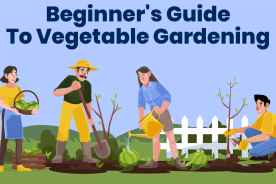Just because you have a small garden does not mean you won’t be able to grow vegetables. A vegetable garden layout will help use your space most efficiently and by using the square foot gardening method you’ll be able to increase your yield, save on water, time and energy.
What is square foot gardening?
The square foot gardening method is the practice of planting in a specific way usually in a raised bed. The bed is divided into square foot sections and a different vegetable is planted in each square foot. The method uses the garden space efficiently and often time increase the yield.
The advantages of square foot gardening are many. Not only does it make the most of every square inch of dirt available, but it is also easy to understand. It takes some planning initially, but it requires less work overall.
Because the plants will use up so much space there is not much room for weeds so time will be saved weeding and water will be conserved. Harvesting is easier and quicker with an efficient layout and you’ll often be able to produce more vegetables in the smaller space than you would with traditional row cropping.
Garden designs
The square foot gardening method is often practiced in a raised bed. You can build your own or purchase a pre-made bed. Try not to make the bed wider than 4 feet in one direction. Anything wider than that will be difficult to work the middle.
Select a sunny location that receives at least 6 to 8 hours of sun per day. You’ll also want to be sure you can conveniently water your plants. Fill your bed with good, fertile soil. You can make your own or buy a mix. A combination of about ½ top soil and ½ high-quality compost is a good ratio.
Mel Bartholomew, author of the book Square Foot Gardening, recommends using a mix of 1/3 compost, 1/3 peat moss, and 1/3 vermiculite. The compost should be made using at least 5 different sources for a variety of nutrients. Examples include manure, green waste, or yard waste. Make sure the mix is at least 6 inches deep in your bed.
Vegetable garden layout
To plan your garden start by measuring your bed and then plotting it on graph paper. The idea of square foot gardening is to use each square foot to grow a different type of vegetable. You will not need to include walking or work space in the bed. You will be walking and working from the outside.
Place taller vegetables on the north side. Vining and tall plants, such as green beans, squash, and cucumbers, and tomatoes, will need a trellis or support to grow up rather than out. For cooler weather crops determine the date of maturity (found on the seed packet) and decide what warm-season plants you will plant in that square after harvest.
Before you begin planting use string to divide your raised bed into square foot sections. This will help you get the spacing correct. Create a permanent grid using trim, nails and string, wood lathe, PVC, etc. Try to keep your grid up for the whole season to help when you replant.
Proper care and maintenance of your garden bed is the best means of success. Be sure to water often to keep the bed moist, not wet, and weed as often as you can. Rotate the different types of plants throughout the garden from year to year. Growing the same plant in the same space year after year is an invitation for disease.
Square foot gardening spacing
The size of the mature plant will determine how many seeds to plant in each square. You will grow either, 1, 4, 9, or 16 equally spaced plants per square foot. Use your finger to divide the square into a smaller grid. Large plants will only have one seed in the middle of the square foot. Smaller plants will need the square divided into a 16-section grid. Plant one seed or two seeds per spot. Do not plant more to prevent the extra work of constantly thinning over-crowded plants.
Square foot garden planner
The table below describes the particular spacing required for each plant. If your plant is not listed use the plant spacing, not row spacing, on the seed packet to help you determine the layout.





No Comments